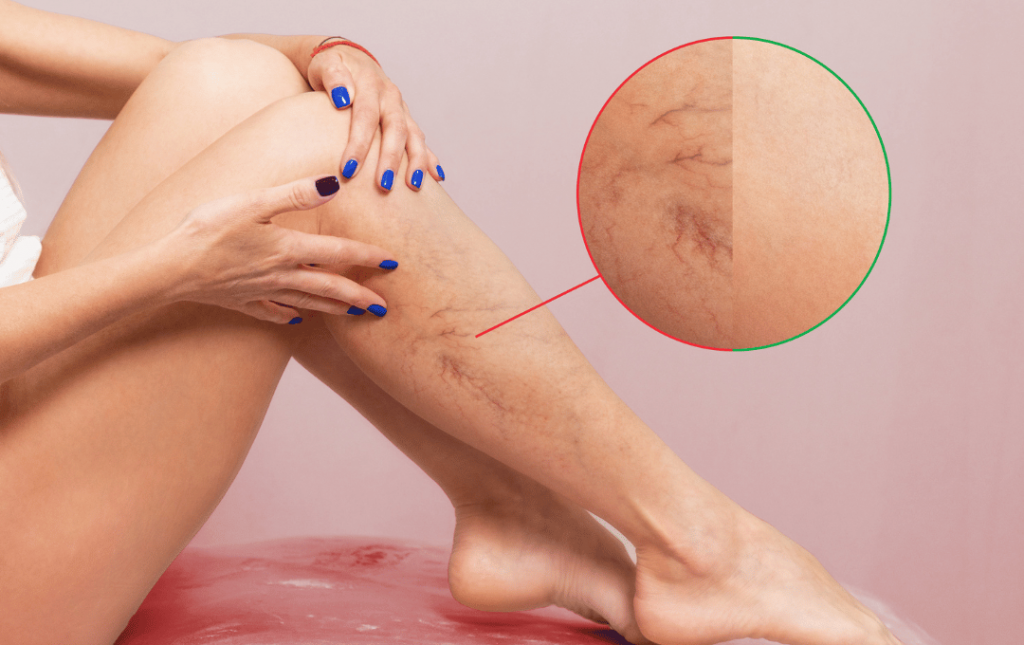Pain, cramping, or discomfort in your legs and feet, especially when walking, could signal blocked arteries. Healthy peripheral arteries carry blood, oxygen, and nutrients to the lower extremities, essential to overall health. However, when blockages occur- a condition called Peripheral Artery Disease (PAD)- this essential flow is reduced. Because PAD tends to worsen over time, addressing symptoms early is important for your health and mobility.
If you’re concerned that you may have symptoms of blocked arteries in the legs, we encourage you to talk to one of our vascular doctors at USA Vascular Centers. We offer leading PAD diagnosis tests and treatments, such as angioplasty, stent placement, and atherectomy, to help reduce PAD symptoms so you can get back to living your life symptom-free.
SCHEDULE A TREATMENT CONSULTATION
What Is a Blocked Artery in the Leg?
A blocked artery is typically caused by a plaque buildup known as atherosclerosis, which contains fatty deposits made of fats, calcium, and cholesterol. A plaque buildup can cause the arteries to narrow, making it harder for blood to flow freely.
Risk factors that can lead to atherosclerosis include high cholesterol, diabetes, high blood pressure, obesity, smoking, and chronic inflammation.. These factors also increase the risk of a more serious health condition called peripheral artery disease.
How Peripheral Artery Disease (PAD) Leads to Blocked Leg Arteries
When atherosclerosis occurs, plaque accumulates in the arteries. This causes the arteries to narrow and reduces blood flow, leading to peripheral artery disease. PAD specifically impacts arteries that supply blood to the legs and feet.
However, atherosclerosis can also cause coronary artery disease (CAD), a condition that impacts the arteries that supply blood to the heart. Both can be caused by atherosclerosis, but they affect different arteries.
What Are the Symptoms of Clogged Arteries in the Legs?
Symptoms of blocked arteries in the leg can vary from patient to patient. Here are a few early and advanced symptoms to look out for:
Early Signs of a Blocked Artery in the Leg
Early signs of a blocked artery may include discoloration of the skin in the affected area, cold feet and legs, lower back pain, fatigue, dizziness, or shortness of breath.
Claudication can also occur, causing cramping and discomfort in the legs while walking, which is relieved by rest. Patients may also experience a ‘pins and needles’ sensation in the feet and toes.
Advanced Symptoms of Blocked Arteries in the Legs
When peripheral artery disease progresses, leg pain may persist at rest, especially at night. During more advanced stages of PAD, some patients experience slow-healing ulcers, non-healing wounds, and the death of tissue in their legs or feet. This happens when blood circulation is completely (or almost completely) cut off. As soon as the skin, bones, muscles, and other tissues stop receiving any oxygen or nutrients, they begin to die. As gangrene sets in, the skin will turn a blackish-green color.
Without immediate treatment, bacteria from the dead tissue can spread throughout the body, creating a life-threatening situation. Patients with gangrene often need amputation to minimize this risk.
When to Worry About Leg Pain
If you’re experiencing severe discomfort in your lower extremities, even without physical exertion, or if your leg pain is disrupting your sleep, schedule a consultation with a vascular specialist. Early prevention can slow the progression of symptoms and prevent atherosclerosis from worsening.
SPEAK WITH A VASCULAR SPECIALIST
What Is the Treatment for Blocked Arteries in the Legs?
If you suspect you have a blocked artery in your legs caused by PAD, consider scheduling a screening at USA Vascular Centers. A vascular doctor at one of our outpatient facilities will provide an accurate diagnosis and a personalized treatment plan.
Our highly skilled doctors perform three minimally invasive PAD treatments based on your condition:
- Angioplasty: This minimally invasive procedure treats a blocked artery in the legs by using a balloon-tipped catheter to open up narrowed or blocked arteries. This helps promote better blood circulation. Peripheral angioplasty is used to treat plaque buildup (atherosclerosis) in the arteries that carry blood to the lower extremities.
- Stent placement: A mesh stent is placed inside the artery wall to keep it propped. Stent placements help treat blocked arteries in the legs by preventing the artery from narrowing again and improving blood flow. It can be performed with or without an angioplasty.
- Atherectomy: This procedure opens a blocked artery in the legs using a catheter tipped with a laser or a tiny blade to cut the plaque into pieces. To keep the pieces of plaque from traveling through the bloodstream, they are collected in a special chamber on the catheter and removed from the body.
These non-surgical vascular treatments require no stitches, allowing you to recover in the comfort of your home. Receiving treatment to help clear blocked arteries in the legs can help you manage painful symptoms and improve your quality of life.
How Long Can You Live With Blocked Arteries in the Legs?
The life expectancy of a person with blocked arteries due to peripheral artery disease depends on the severity of the condition and an individual’s overall health. PAD is a progressive disease that worsens with time. If left untreated, it can increase your risk of heart disease and stroke. In some cases, non-healing wounds can progress to gangrene and lead to amputation.
Take the First Step Toward Better Vascular Health
Blocked or clogged arteries in the legs due to PAD can cause a host of uncomfortable symptoms and dangerous complications. If you’re experiencing pain and discomfort in the legs, contact USA Vascular Centers for an accurate diagnosis.
Our team will develop a personalized treatment plan using minimally invasive treatments. We’re fully accredited by the Accreditation Association for Ambulatory Health Care (AAAHC) and have over 45 locations in the United States.
Schedule a consultation online or call us at 888.773.2193 today.
FAQs About Blocked Arteries in the Legs
Are blocked arteries reversible?
No, blocked arteries in the legs caused by atherosclerosis cannot be reversed. However, early intervention and treatment can slow the progression and reduce blockages.
Do blocked arteries in the legs always cause symptoms?
No, some patients experience asymptomatic PAD, which is why annual vascular screenings are important, especially for those with other health issues such as diabetes or heart disease.
What doctor treats blocked arteries in the legs?
Blocked arteries in the legs are treated by a vascular doctor or specialist who will diagnose your condition and offer expert treatment recommendations based on the severity.



